
What has the Hubble Space Telescope discovered?
Since its 1990 launch, Hubble Space Telescope has been dazzling the world with images of space and a deeper understanding of how the universe works.
The Hubble Space Telescope remains one of the best telescopes in the world despite its age and only modest size. Compared to the vast 8-10m telescopes built on the ground, with even larger ones planned in the future, the 2.4m Hubble mirror is relatively average for modern day research telescopes, and with optics that are approaching their third decade of use. However, it consistently outperforms many of the most advanced ground-based telescopes and is still considered the pinnacle of optical and ultraviolet astronomy, with demand for its use in research greatly exceeding the available observing time each year.
Top 3 Hubble facts
1. Hubble travels at a speed of 17,500 mph and has covered a distance equivalent to a trip to Neptune, the furthermost planet in our solar system.
2. Hubble has peered back into the very distant past, to locations more than 13.4 billion light years from Earth.
3. Since its mission began in 1990, Hubble has made more than 1.3 million observations.
What has Hubble found?
Hubble's success is in no small part due to its position high above the atmosphere, removing many effects that hamper ground-based observers. In fact, ultraviolet astronomy is all but impossible to complete from the ground due to the presence of gases like ozone that block ultraviolet light in the upper atmosphere. Thanks to this and the lack of the turbulent air currents that make stars look like they are twinkling, Hubble is able to take some of the sharpest and deepest images of our Universe.
When Hubble shows us images in space, the view it gives us is always of how objects looked some time in the past. This is because light takes time to travel the long distances from the objects it came from. Even with relatively local objects the delay can be impressive, with our nearest neighbouring galaxy, the Andromeda galaxy, being viewed as it was almost 2.5 million years ago. This means telescopes like Hubble act like time machines, enabling us to study the history of our Universe.
Here are some of its major contributions to science:
- Helped pin down the age for the universe now known to be 13.8 billion years, roughly three times the age of Earth.
- Discovered two moons of Pluto, Nix and Hydra.
- Helped determine the rate at which the universe is expanding.
- Discovered that nearly every major galaxy is anchored by a black hole at the centre.
- Created a 3-D map of dark matter.
Hubble discoveries | a timeline
1990 | The Hubble Space Telescope is launched, after almost twenty years of planning.
1993 | When Hubble was first launched, a mistake with its mirror caused a large blurring effect that severely hampered its ability to complete ground breaking astronomy. The first servicing mission to Hubble had astronauts on the Endeavour space shuttle fix a flaw in Hubble’s mirror, bringing its optics to the stunning level of detail we see today.
1994 | Hubble witnessed a rare cometary impact, taking snapshots of a huge plume of debris left behind Comet Shoemaker-Levy 9 after it collided with Jupiter. Hubble also provided conclusive evidence for the existence of Supermassive Black Holes in the centres of galaxies by observing the galaxy M87.
1995 | Hubble took the famous photo of the Eagle Nebula which was later named 'pillars of creation'.
2001 | Hubble measured the elements in the atmosphere of the exoplanet HD 209458b.
2004 | The Hubble Ultra Deep Field was released allowing astronomers to look even further back in the time of the cosmos.
2005 | Hubble photographed two previously unknown moons orbiting Pluto.
2007 | Hubble observations showed that the dwarf planet Eris was bigger than Pluto. Hubble also assisted the production of a 3D-map showing the distribution of dark matter in the Universe.
2008 | Hubble took a picture of the exoplanet Formalhaut b, the first visual image of an exoplanet. In the same year Hubble found organic molecules on an extrasolar planet and the telescope’s 100 000th orbit around Earth was celebrated.
2010 | Hubble images revealed distant galaxies with likely redshifts (a measure of distance used in cosmology) greater than 8, showing the Universe as it was when it was less than a tenth of its current age. Hubble also photographed a never-before-seen evidence of a collision between two asteroids.
2011 | Hubble made its millionth observation, a spectroscopic analysis of the exoplanet HAT-P-7b. The 10,000th scientific paper using Hubble data was published.
2012 | Images taken by Hubble showed seven primitive galaxies from a distant population that formed more than 13 billion years ago. The images showed the galaxies as they were when the Universe was less than 4 percent of its present age. Later in the year that record was broken when Hubble discovered an object from when the Universe was only 3 percent of its present age, only 470 million years after the Big Bang.
2013 | Hubble was used to determine for the first time the true colour of a planet orbiting another star and found water vapour erupting off the surface of Jupiter’s moon Europa.
2014 | Hubble became the first telescope ever to observe an asteroid disintegrating and revealed the most detailed weather map for an exoplanet ever.
2015 | Hubble observed, for the first time, the effect of gravitational lensing on a distant exploding star, where the powerful gravity of a foreground galaxy acts like a cosmic magnifying glass, enhancing and splitting the image into a cross-shaped pattern of light.
Who was the Hubble Space Telescope named after?
The telescope was named after American astronomer Edwin Hubble. Born in 1889, Hubble discovered that many objects previously thought to be clouds of dust and gas and classified as nebulae were actually galaxies beyond the Milky Way. Working at the Mount Wilson Observatory in California, he made these observations between 1922 and 1923 using a 2.5 metre telescope – the Hooker telescope – which was then the world’s largest.
Hubble’s work on galaxies led him to the realisation that the universe was expanding, overturning scientists’ expectations and eventually leading to the Big Bang model for the birth of the Universe.
How much did the Hubble telescope cost?
Being arguably the most successful telescope of all time comes at a cost. Its original building costs of more than US $2 billion are exceeded only by the upcoming James Webb Space Telescope, and the total running costs of Hubble have now far exceeded US $10 billion. However, it is overwhelmingly seen as worth the money in the astronomical community, not only for the world class astronomy its observations makes possible, but also in order to give people around the world a view of the beauty of astronomy from above the clouds.
Images from the Hubble telescope







